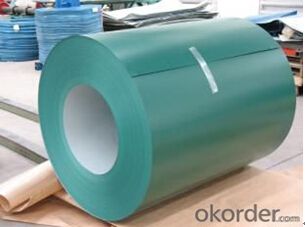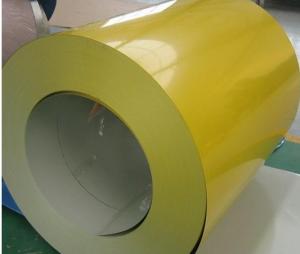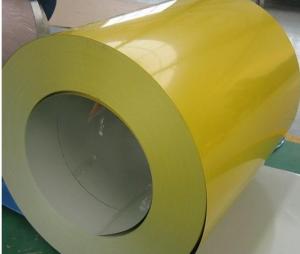Color Coated Gl Steel Sheet PPGI
- Loading Port:
- China Main Port
- Payment Terms:
- TT or LC
- Min Order Qty:
- -
- Supply Capability:
- -
OKorder Service Pledge
OKorder Financial Service
You Might Also Like
1.Structure of Color Coated GI/GL Steel Coil Description
With GI (aluzinc) as base metal, after pretreatment (degrease and chemical treatment) and liquid dope with several layers of color, then after firing and cooling, finally the plate steel is called pre-painted galvanized (aluzinc) steel. Pre-painted galvanized steel is good capable of decoration, molding, corrosion resistance. It generally displays workability, durability and weather resistance.
2.Main Features of the Color Coated GI/GL Steel Coil
• Excellent corrosion resistance
• Excellent weather resistance
• Capability of decoration, molding, corrosion resistance
• Workability, durability
• Excellent heat resistance performance
• High strength
• Good formability
• Good visual effect
3.Color Coated GI/GL Steel Coil Images

4.Color Coated GI/GL Steel Coil Specification
Quality standar: JIS G3312 CGCC & CGLCC
Hardness of P: Both soft and hard quality are available
Surface finish: with or without protect film
Thickness : 0.14-1.20 mm
Width : 914mm, 1000mm, 1220mm and 1250mm, thickness 600-1250mm is available
Finish by coil or sheet: Both sheet and coil are available
8Zinc coating: 60-275G/M2, both sides
Paint thickness for top side : 5 micron primer + (10-20) microns modified polyester, green color.
Paint thickness for back side: (5-10) microns Epoxy
Weight per coil: 4-6 tons, also can be upon customer's requirements
Max loading weight in one 20ft container : 25 tons generally
5. FAQ of Color Coated GI/GL Steel Coil
We have organized several common questions for our clients,may help you sincerely:
1. What is the minimum order quantity ?
Our MOQ is 50mt for each size. And we will consider to give more discount if you make big order like 1000 tons and more. Further more, the more appropriate payment term your offer the better price we can provide.
2. How long can we receive the product after purchase?
Usually within thirty working days after receiving buyer’s advance payment or LC. We will arrange the factory manufacturing as soon as possible. The cargo readiness usually takes 15-25 days, but the shipment will depend on the vessel situation.
3. How to guarantee the quality of the products?
We have established the international advanced quality management system,every link from raw material to final product we have strict quality test;We resolutely put an end to unqualified products flowing into the market. At the same time, we will provide necessary follow-up service assurance.
- Q:in a lab at school we did heat treatment of steelwhat are the possible phases present in the steel sample in as-received, as-quenched and as-tempered conditions? specifically when is it ferrite, austenite and pearliteis the steel originally in the ferrite phase? then when headed turns into austenite and when quenched martensite is formed and when tempered cermentite is formed...........where is pearlite involved and am i correct about the ferrite?
- hey from what i learned in uni last sem, steel is originally ferrite form at first at room conditions. it will undergo poly morphic transformation to become FCC structure austenite form at 912 degree celcius. under conditions, it can become pearlite (which is a combination of ferrite and cementite) or bainitie( a finer form of pearlite). queching conditions to room temperature will form martensite which is the strongest but brittle steel form. tempered cementite is formed when we quench it and then raise temperatures before sir cooling. hope it helps, pls vote me best answer is i deserve it. thanks
- Q:What are the safety considerations when handling steel coils?
- There are several safety considerations that should be taken into account when dealing with steel coils. Firstly, it is crucial to wear the correct personal protective equipment (PPE), such as gloves, safety glasses, and steel-toed boots. This protective gear helps minimize the risk of injuries from sharp edges, flying debris, or accidental contact with the coils. Secondly, it is important to have a clear understanding of the weight and dimensions of the steel coils being handled. Steel coils can be extremely heavy, and improper lifting techniques can lead to back strains, muscle pulls, or even more severe injuries. Therefore, it is crucial to employ proper lifting techniques, such as bending the knees and maintaining a straight back, or using lifting equipment like cranes or forklifts when necessary. Moreover, steel coils can be unstable and susceptible to rolling or shifting during handling. To avoid accidents, it is vital to secure the coils adequately before moving or stacking them. This can be achieved by using appropriate lifting attachments, binding the coils together, or utilizing racks or other storage systems specifically designed for steel coils. Additionally, it is important to be aware of the potential hazards associated with the steel coils, such as sharp edges, oil or grease coatings, or even damage to the coils themselves. It is essential to inspect the coils for any irregularities or defects before handling them, as well as ensuring that they are stored safely and securely to prevent accidents. Lastly, proper communication and training are crucial when dealing with steel coils. Establishing clear channels of communication between workers is essential to ensure that everyone is aware of their roles and responsibilities. Furthermore, providing training on safe handling techniques, potential hazards, and emergency procedures can significantly reduce the risk of accidents and injuries. In conclusion, when handling steel coils, it is important to wear the appropriate PPE, employ proper lifting techniques, secure the coils adequately, be mindful of potential hazards, and ensure effective communication and training. By adhering to these safety considerations, the risk of accidents and injuries can be greatly diminished.
- Q:How does coil slitting work?
- Coil slitting is a process used in metalworking to cut large coils of material, such as steel or aluminum, into narrower strips. It involves feeding the coil through a set of circular knives or rotary slitters that cut the material into desired widths. The slitting process can be adjusted to achieve precise measurements, and the resulting strips are typically rewound onto separate coils or spools. Coil slitting is commonly used in various industries, including automotive, construction, and manufacturing, to obtain narrower strips that can be further processed or used as raw material for different applications.
- Q:I'm a big fan of stainless steel and sterling silver, but not of the humidity of the country I'm in. Therefore I sweat more. Gross, I know. I'm buying a necklace chain for my ring.So does sweat contribute to tarnishing of silver and steel? The real kind?
- steel shouldn't really tarnish, it rusts and moisture increases that. Silver tarnishes when exposed to air and sulfur. Moisture increases the process a bit, but it happens anyway. Sweat is not gross, it's a necessary function of your body, otherwise you would die. A lot of sports people wear jewelry and they sweat a lot. If you wear the jewelry all the time, that will prevent the tarnish a bit. If you take it off, clean it (water and dish washing liquid), dry it and put it in a zip lock back to keep it away from air and moisture. In the end, cleaning the jewelry is quick and easy so don't worry about it.
- Q:What are the common challenges in steel coil manufacturing?
- Steel coil manufacturing often encounters several challenges that manufacturers must address. One key issue involves the need to consistently uphold quality standards throughout the manufacturing process. Meeting precise specifications is crucial for steel coils, as any deviations can result in product defects or rejections. Therefore, constant monitoring and implementing quality control measures at each production stage are necessary. Another obstacle involves optimizing production efficiency and minimizing downtime. The production of steel coils encompasses various intricate processes, including cutting, forming, welding, and finishing. Delays or problems in any of these stages can create production bottlenecks, negatively impacting overall efficiency and productivity. Additionally, challenges arise in the handling and storage of steel coils. Due to their weight, steel coils can be challenging to manipulate, necessitating specialized equipment and proper worker training. Moreover, maintaining appropriate storage conditions is vital to prevent damage from factors like moisture, corrosion, or other environmental elements. Maintaining a safe working environment poses another challenge in steel coil manufacturing. Improper operation or maintenance of the equipment and machinery used in the process can lead to hazardous situations. Therefore, ensuring worker safety and implementing suitable safety protocols are crucial to prevent accidents and injuries. Lastly, fluctuating raw material costs and market demands present challenges for steel coil manufacturers. The profitability of the manufacturing process is significantly influenced by the costs of raw materials like iron ore and scrap metal. Furthermore, market demands for specific steel coil types can fluctuate, necessitating manufacturers to adapt and adjust their production accordingly. To overcome these challenges, careful planning, continuous improvement, and effective resource and process management are essential in steel coil manufacturing.
- Q:How are steel coils used in the manufacturing of industrial valves?
- Steel coils are used in the manufacturing of industrial valves as they provide the necessary raw material for creating valve bodies, stems, and other components. The coils are shaped, cut, and formed into different valve parts, ensuring strength and durability. These steel components are then assembled, welded, and machined to create fully functional industrial valves used in various applications such as oil and gas, chemical processing, and water treatment industries.
- Q:3 bedroom rambler with attached garage. A bad hail storm in May damaged my white siding and roof. I am concerned insurance adjustThanks much.er will not give me replacement value for steel siding. Any one know the cost and where to buy in Minnesota.
- they both cost around the same
- Q:steel of beam has been rusted ,how can i repair it?
- The rust needs to be removed by what ever means works best for your situation.. Often a twisted wire wheel on a 4 1/2 angle grinder works quickly... a hand wire brush may work well for you, or just plain sandpaper and a LOT of elbow grease (hard work) will remove the rust. From there, a coat of primer paint made for steel. Any hardware store in your area would have such a primer, in quart cans or spray cans. Once that is dry (a good 24 hours for most formulations), you can spray or brush paint the beam most any color you wish.. I've had very good luck with acrylic enamel paints for such projects.. IF your steel is badly pitted, you should consider getting it inspected to insure it will still hold up or support what ever it was installed to do. If you want a smooth finish, once the rust removal is done, you can fill in the dips and pock marks with an auto body filler (Bondo is one brand name)... It comes in 2 parts (the main filler and a hardener) that are mixed well and used to fill in the holes and divits with a plastic spreader.. Once hard (in a few minutes with most brands of filler), sanding with sandpaper and a sanding block will smooth out the finish very nicely. From there, the same primer mentioned above and paint will finish up your project... Hope this helps some... Good Luck!
- Q:Can steel coils be stored in a humid environment?
- Steel coils can be stored in a humid environment, but it is not ideal. Humidity can cause steel coils to rust and corrode, leading to potential damage or degradation of the steel. It is recommended to store steel coils in a dry and well-ventilated area to protect them from the negative effects of humidity.
- Q:what is the chemical process that makes steel harder when it is heated and cooled rapidly?what does the heating of it do to the atoms?what does the cooling of it do to the atoms?what makes tempered steel so strong compared to untempered steel?
- You can't temper all steels. Generally the material must be a high-carbon or tool steel. Different alloys temper differently, and tempering is usually done to get a specific set of characteristics, so you must know what you are working with and use the right methods and temperature. If you do it wrong, the material may be hard but too brittle for the purpose or have other issues. It can be simple, such as heating to a dull red, carbonizing the surface (use an acetylene rich flame until it blackens the surface) and oil quenching. Do that to a piece of tool steel (like a screwdriver) and it will case (surface) harden it to the point you can't scratch it with a file. Tempering changes the way the molecular structure in the metal is linked and oriented.
1. Manufacturer Overview |
|
|---|---|
| Location | |
| Year Established | |
| Annual Output Value | |
| Main Markets | |
| Company Certifications | |
2. Manufacturer Certificates |
|
|---|---|
| a) Certification Name | |
| Range | |
| Reference | |
| Validity Period | |
3. Manufacturer Capability |
|
|---|---|
| a)Trade Capacity | |
| Nearest Port | |
| Export Percentage | |
| No.of Employees in Trade Department | |
| Language Spoken: | |
| b)Factory Information | |
| Factory Size: | |
| No. of Production Lines | |
| Contract Manufacturing | |
| Product Price Range | |
Send your message to us
Color Coated Gl Steel Sheet PPGI
- Loading Port:
- China Main Port
- Payment Terms:
- TT or LC
- Min Order Qty:
- -
- Supply Capability:
- -
OKorder Service Pledge
OKorder Financial Service
Similar products
New products
Hot products
Related keywords






























